
Concept explainers
(a)
Interpretation: The name of the following compound needs to be determined.

Concept Introduction : The name of an organic compound has three parts, prefix, parent chain and suffix. The format of naming is prefix+parent chain+suffix. The parent chain is the longest chain of carbon atoms in the compound. Suffix denote the name of
(a)
Answer to Problem 15E
The name of the compound is 1,3-dichlorobutane.
Explanation of Solution
The compound is as follows:

First identify the parent chain of the compound. The parent chain consists of four carbon atoms. So, the name of parent chain is ‘but’. The compound consist of only single bonds so, name of suffix ‘ane’ should be used. Two chlorine atoms present in C1 and C3. So, the name of the compound is 1,3-dichlorobutane.
(b)
Interpretation: The name of the following compound needs to be determined.
Concept Introduction : The name of an organic compound has three parts, prefix, parent chain and suffix. The format of naming is prefix+parent chain+suffix. The parent chain is the longest chain of carbon atoms in the compound. Suffix denote the name of functional group and prefix denote the substituent present in the compound.
(b)
Answer to Problem 15E
The name of the compound is 1,1,1-trichlorobutane
Explanation of Solution
The compound is
(c)
Interpretation: The name of the following compound needs to be determined.
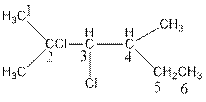
Concept Introduction : The name of an organic compound has three parts, prefix, parent chain and suffix. The format of naming is prefix+parent chain+suffix. The parent chain is the longest chain of carbon atoms in the compound. Suffix denote the name of functional group and prefix denote the substituent present in the compound.
(c)
Answer to Problem 15E
The name of the compound is 2, 3-dichloro-2-4-dimethyhexane
Explanation of Solution
The compound is as follows:
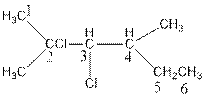
The parent chain consists of six carbon atoms. So, the name of parent chain is ‘hex’. Only single bonds present in the compound. So, suffix would be ‘ane’. Two chlorine atoms present in C2 and C3 and two methyl atoms present in C2 and C4. So, the name of the compound is 2,3-dichloro-2-4-dimethyhexane.
(d)
Interpretation: The name of the following compound needs to be determined.
Concept Introduction: The name of an organic compound has three parts, prefix, parent chain and suffix. The format of naming is prefix+parent chain+suffix. The parent chain is the longest chain of carbon atoms in the compound. Suffix denote the name of functional group and prefix denote the substituent present in the compound.
(d)
Answer to Problem 15E
The name of the following compound is 1,2-difluoroethane
Explanation of Solution

In
(e)
Interpretation: The name of the following compound needs to be determined.

Concept Introduction: The name of an organic compound has three parts, prefix, parent chain and suffix. The format of naming is prefix+parent chain+suffix. The parent chain is the longest chain of carbon atoms in the compound. Suffixdenote the name of functional group and prefix denote the substituent present in the compound.
(e)
Answer to Problem 15E
The name of the compound is 3-iodobut-1-ene.
Explanation of Solution
The compound is,

The parent carbon chain consists of four carbon atoms. So, the name of the parent chain is ‘but’, double bond present. So, name of suffix is ‘ene’. One iodine atom present at C3. So, the name of the compound is 3-iodobut-1-ene.
(f)
Interpretation: The name of the following compound needs to be determined.
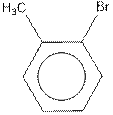
Concept Introduction: In naming of benzene compound prefix is used to denote the substituents present in the compound before the word ’benzene’. If more than one substituent is present, then the substituents are arranged in alphabetical order.
(f)
Answer to Problem 15E
The name of the compound is 1-bromo-2-methylbenzene.
Explanation of Solution
The name of the compound is as follows:
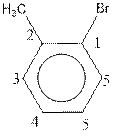
The compound is a benzene compound. One bromine atom is present at C1 and one methyl group is at C2. So, the name of the compound is 1-bromo-2-methylbenzene.
(g)
Interpretation: The name of the following compound needs to be determined.

Concept Introduction: In naming of cyclic compound, naming is done in the format,
Prefix+Cyclo+parent chain+suffix
Prefix denotes the name of the substituent. If more than one substituent is present then they should be arranged in alphabetical order.
(g)
Answer to Problem 15E
The name of the compound is 1-bromo-2-methylcyclohexane.
Explanation of Solution
The compound is as follows:
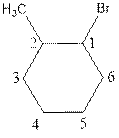
The above compound is cyclic compound. One bromine atom is present at C1 and one methyl atom is present at C2. And the parent chain consists of six carbon atoms. So, the name of the compound is 1-bromo-2-methylcyclohexane.
(h)
Interpretation: The name of the following compound needs to be determined.
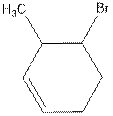
Concept Introduction: In naming of cyclic compound, naming is done in the format,
Prefix+Cyclo+parent chain+suffix
Prefix denotes the name of the substituent. If more than one substituent is present, they should be arranged in alphabetical order.
(h)
Answer to Problem 15E
The name of the compound is 1-bromo-2-methylcyclohex-3-ene.
Explanation of Solution
The compound is as follows:
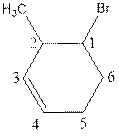
The above compound is cyclic compound. One bromine atom is present at C1 and one methyl atom is present at C2. The parent chain consists of six carbon atoms and one double bond at C3. So, the name of the compound is 1-bromo-2-methylcyclohex-3-ene.
Want to see more full solutions like this?
Chapter 21 Solutions
EBK CHEMICAL PRINCIPLES
- Identify and provide a concise explanation of the concept of signal-to-noise ratio (SNR) in the context of chemical analysis. Provide specific examples.arrow_forwardIdentify and provide a concise explanation of a specific analytical instrument capable of detecting and quantifying trace compounds in food samples. Emphasise the instrumental capabilities relevant to trace compound analysis in the nominated food. Include the specific application name (eg: identification and quantification of mercury in salmon), outline a brief description of sample preparation procedures, and provide a summary of the obtained results from the analytical process.arrow_forwardIdentify and provide an explanation of what 'Seperation Science' is. Also describe its importance with the respect to the chemical analysis of food. Provide specific examples.arrow_forward
- 5. Propose a Synthesis for the molecule below. You may use any starting materials containing 6 carbons or less (reagents that aren't incorporated into the final molecule such as PhзP do not count towards this total, and the starting material can have whatever non-carbon functional groups you want), and any of the reactions you have learned so far in organic chemistry I, II, and III. Your final answer should show each step separately, with intermediates and conditions clearly drawn. H3C CH3arrow_forwardState the name and condensed formula of isooxazole obtained by reacting acetylacetone and hydroxylamine.arrow_forwardState the name and condensed formula of the isothiazole obtained by reacting acetylacetone and thiosemicarbazide.arrow_forward
- Provide the semi-developed formula of isooxazole obtained by reacting acetylacetone and hydroxylamine.arrow_forwardGiven a 1,3-dicarbonyl compound (R1-CO-CH2-CO-R2), indicate the formula of the compound obtaineda) if I add hydroxylamine (NH2OH) to give an isooxazole.b) if I add thiosemicarbazide (NH2-CO-NH-NH2) to give an isothiazole.arrow_forwardAn orange laser has a wavelength of 610 nm. What is the energy of this light?arrow_forward
- The molar absorptivity of a protein in water at 280 nm can be estimated within ~5-10% from its content of the amino acids tyrosine and tryptophan and from the number of disulfide linkages (R-S-S-R) between cysteine residues: Ε280 nm (M-1 cm-1) ≈ 5500 nTrp + 1490 nTyr + 125 nS-S where nTrp is the number of tryptophans, nTyr is the number of tyrosines, and nS-S is the number of disulfide linkages. The protein human serum transferrin has 678 amino acids including 8 tryptophans, 26 tyrosines, and 19 disulfide linkages. The molecular mass of the most dominant for is 79550. Predict the molar absorptivity of transferrin. Predict the absorbance of a solution that’s 1.000 g/L transferrin in a 1.000-cm-pathlength cuvet. Estimate the g/L of a transferrin solution with an absorbance of 1.50 at 280 nm.arrow_forwardIn GC, what order will the following molecules elute from the column? CH3OCH3, CH3CH2OH, C3H8, C4H10arrow_forwardBeer’s Law is A = εbc, where A is absorbance, ε is the molar absorptivity (which is specific to the compound and wavelength in the measurement), and c is concentration. The absorbance of a 2.31 × 10-5 M solution of a compound is 0.822 at a wavelength of 266 nm in a 1.00-cm cell. Calculate the molar absorptivity at 266 nm.arrow_forward
 Introductory Chemistry: A FoundationChemistryISBN:9781337399425Author:Steven S. Zumdahl, Donald J. DeCostePublisher:Cengage Learning
Introductory Chemistry: A FoundationChemistryISBN:9781337399425Author:Steven S. Zumdahl, Donald J. DeCostePublisher:Cengage Learning Chemistry for Engineering StudentsChemistryISBN:9781337398909Author:Lawrence S. Brown, Tom HolmePublisher:Cengage Learning
Chemistry for Engineering StudentsChemistryISBN:9781337398909Author:Lawrence S. Brown, Tom HolmePublisher:Cengage Learning World of Chemistry, 3rd editionChemistryISBN:9781133109655Author:Steven S. Zumdahl, Susan L. Zumdahl, Donald J. DeCostePublisher:Brooks / Cole / Cengage Learning
World of Chemistry, 3rd editionChemistryISBN:9781133109655Author:Steven S. Zumdahl, Susan L. Zumdahl, Donald J. DeCostePublisher:Brooks / Cole / Cengage Learning ChemistryChemistryISBN:9781305957404Author:Steven S. Zumdahl, Susan A. Zumdahl, Donald J. DeCostePublisher:Cengage Learning
ChemistryChemistryISBN:9781305957404Author:Steven S. Zumdahl, Susan A. Zumdahl, Donald J. DeCostePublisher:Cengage Learning
 Chemistry: An Atoms First ApproachChemistryISBN:9781305079243Author:Steven S. Zumdahl, Susan A. ZumdahlPublisher:Cengage Learning
Chemistry: An Atoms First ApproachChemistryISBN:9781305079243Author:Steven S. Zumdahl, Susan A. ZumdahlPublisher:Cengage Learning





